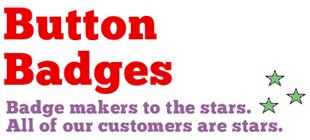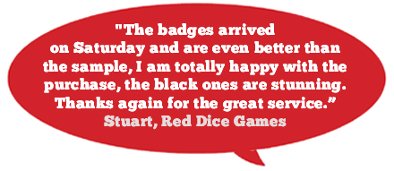The History of Button Badges
One Inch badges were first produced in the USA towards the end of the Nineteenth Century as a low cost alternative to the medallions, pendants, and "badges" of the day that were expensive to make. Their size gave rise to the name "button" or "button badge".
The invention of celluloid in 1869 by John Wesley Hyatt gave the world its first semi-synthetic plastic and it was crucial in the development of a whole new range of products including button badges.
Thin sheets of celluloid could be used to cover paper and give the effect of the traditional enamel badge without the cost or labour skills needed to work with enamel. It also meant that less metal could be used in producing badges and there was no longer any need for soldering or screwing.
All that was needed was a printed image and a thin sheet of celluloid to cover it (both cut to size, usually circular and one inch in diameter, with the celluloid slightly overlapping the paper so that it would hold it in place). A pressed metal shell was produced and a simple machine used to press the paper, celluloid and shell together. A metal ring was then attached to the back of the badge to hold the badge together, again by the use of a simple press. Finally a pin was clipped into the back of the badge so that it could be fixed to an item of clothing.
Benjamin S. Whitehead was the man who gave us the button badge. In 1893, he patented the insertion of a sheet of a celluloid transparent film over a photograph mounted on a badge to protect the image from scratches and abrasion. Another patent was issued to his New Jersey company, Whitehead & Hoag, in 1896 for a "Badge Pin or Button" which used a metal pin anchored to the back of the button to fasten the badge.
Thanks to Benjamin Whitehead, the button badge was born.
Smaller badges are still called buttons or pins, particularly in the USA, but in the UK they are best known as button badges - for no other reason than they are more often than not the size of a button.
Plastic badges have been made in recent years, but the traditional metal button badge - as made by us here at buttonbadges.co.uk - are still made in the same way and to the same high standard as they were over 100 years ago. Certainly the components we use haven't changed for decades, with the only real difference between the early button badges and the ones we make today being the use of plastic acetates instead of celluloid ones and a D pin back instead of an open pin.

Whitehead & Hoag were one of the biggest manufacturers of circular button badges during the first half of the twentieth century. They made badges not just for the American market, but for export too. At the time of the Second Boer War (1899–1902), badges arrived in Britain with messages like "Only One Order - Forward!" and "England Expects Every Man To Do His Duty". They proved very popular in a country gripped by the wave of patriotism that accompanied the war.
Another early pioneer of the use of badges was none other than Mahatma Ghandi. In 1907, as part of the campaign for Indian independence, badges known as Mutiny Buttons were made to commemorate the Indian Mutiny of 1857 and distributed in London.
Today's love of button badges dates back to the 1960s and early Seventies when they were used by students, hippies and musicians, often as a symbol of protest. John Lennon loved them and from then onwards the one inch button badge has always been seen as a cool thing to wear.

The British Museum (Great Russell Street London WC1B 3DG) held an exhibition in 2004 to celebrate the role of button badges in society entitled "Status Symbols: Identity And Belief On Modern Badges". It features some early examples of button badges, including a Queen Victoria jubilee badge, as well as others such as the Smiley badge and the classic "Ban The Bomb" badge.
A book to accompany the exhibition was produced called The British Museum Book of Badges (ISBN 978-0714150147).
No history of badges would be complete without reference to the classic line from the silver screen: "Badges? We don't need no stinkin' badges!" More about that here
And what about Button Badges? It was started in 1988 by George Marshall who won £2,000 in a writing competition and who then invested half of that money in buying his first badge making machine. The rest as they say is history!




